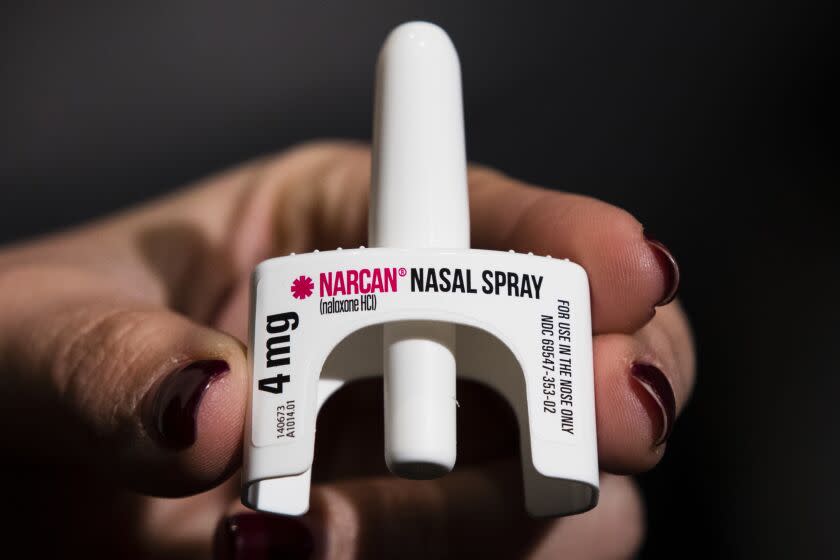Editorial: Haven't we learned yet? Harsher penalties won't save us from fentanyl

Who made fentanyl?
Not the legitimate stuff that's prescribed for post-surgical pain, but the illicit street drug that’s killing Americans at a frightening pace. It's concocted in labs in the U.S. and Mexico, using chemicals shipped from China, India and elsewhere overseas.
But in a very real sense, the co-manufacturer is U.S. criminal justice policy. The war on drugs made fentanyl — much as it turned morphine into heroin and cocaine into crack.
Illicit drug makers trying to evade authorities seek ways to pack more punch into smaller packages in order to make their wares progressively cheaper to transport, easier to hide and quicker to hook the ultimate user.
Marijuana legalization activist Richard Cowan called it the iron law of prohibition: the harder the enforcement, the harder the drugs.
Not just harder, though, but more hazardous, because the buyers at the end of the black market chain may not even know fentanyl has been mixed in with the drugs they purchased. Fentanyl now taints counterfeit pain and anxiety pills sold in Mexican pharmacies and on the dark web and peddled among high school students.
And now there’s tranq — the street name for xylazine, a horse tranquilizer. The veterinary medicine's effects somewhat mimic what users expect from opioids, so it’s appearing in fentanyl. People who think they’re buying fake Percocet may ingest xylazine and die from it without ever knowing they were putting horse tranquilizer in their bodies. Survivors often suffer rotting flesh wounds that cannot be treated with usual remedies.
No doubt there will be new restrictions on veterinary anesthetics, followed by interdiction, tough criminal sentencing of sellers — and then emergence of a cheaper and more powerful substitute. That’s the pattern. Enforcement never reduces demand.
Several times in recent history, the nation has faced an epidemic of destructive drug use and had to pick between a criminal justice or public health response. Almost every time, we’ve chosen the wrong path.
Think of the response network we might have built had we seen the crack epidemic of the 1980s and early 1990s for the health crisis it was. Street teams to help people in overdose crisis, testing to ensure supplies aren’t tainted, clinics to help former users recover, community support, employment, education, respect and a sense of common purpose and destiny instead of hatred and revulsion for the poor, the sick and people of color. More doctors, nurses, clinicians, peer counselors. More funding to attract and support them, more laws to encourage treatment and candor without fear of prosecution.
Imagine how that more robust public health infrastructure and deeper public familiarity and confidence in it might have helped us better handle the prescription opioid crisis. Or COVID-19. Or fentanyl.
Instead we chose to escalate already bloated public spending on police, prosecution and prison. That’s what we know best, and the first tool we think of for responding to drug-related waves of illness and death that epidemiologists say move through the population and should be managed much like influenza, HIV or the coronavirus.
We don't lock up people with contagious disease as our forebears once did, although AIDS touched the fearful part of our collective psyche, and early in the crisis some leaders called for criminal sanctions and exile of patients. But our more modern, more sophisticated and more humane selves eventually won out.
So how will it be with fentanyl? A California State Assembly committee on Thursday is due to take up a number of bills intended to respond to the overdose and poisoning crisis. Most proposals follow the route of fear and failure: harsher penalties, longer sentences. We know what’s at the end of that road. It’s fantasy to think that we can interdict or punish our way out of this crisis, or that a criminal sanction will better dissuade someone from ingesting an illegal drug than the prospect of instant death or rotting flesh. It is magical thinking to believe that we will stop demand, or that manufacturers will quit and find a more wholesome line of work.
But if our goal is to stop the dying, we know what to do, even though we’ve so rarely done it before. Make readily available testing of illegal substances without fear of prosecution. Provide broad access to overdose antidotes such as Narcan for fentanyl, and expand research to find a similar antidote for tranq. Promote harm reduction techniques such as safer supplies of illicit drugs, safe consumption sites, clinics for recovery, funding and legal infrastructure to match.
We’re back at the crossroads. This time we can choose a better path. Or we can pick the wrong one all over again.
This story originally appeared in Los Angeles Times.

